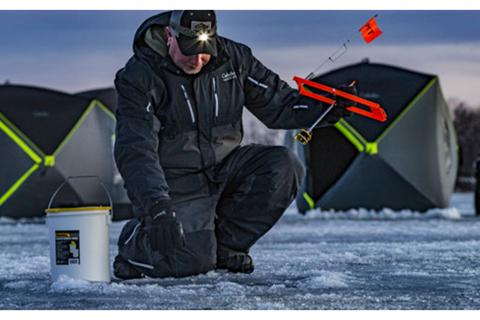
Ice-fishing is a winter tradition across much of the northern United States and throughout Canada. Whether you are getting ready for the upcoming season, or heading out for the first time in midwinter, it’s important to pull out the ice ice fishing tip-ups and get them ready for fishing.
Clam Outdoors pro staffer Robby Rhembrandt, who has shared his ice-fishing expertise with customers in seminars at Cabela’s stores, provided tips on how he rigs his tip-ups.
How to Increase Your Ice Fishing Efficiency

1. Each fall, Rhembrandt replaces all the line on his tip-ups. On his walleye and northern pike rigs, he uses 10- or 20-pound Woodstock Tip-Up Line, to which he’ll connect a 3- to 8-foot fluorocarbon leader, 10-pound test. Tip-up line is not like braided, monofilament or other fishing lines used on reels, he said. It is more like braided string, with a larger diameter.
With tip-ups, you bring fish in by pulling in the line hand over hand, not on a reel, so the larger diameter line is easier to grab and pull in, even with gloves. The line is also durable, and if it freezes on the spool or ices up, you can pull it and break it free without worry of breaking the line.
2. Rhembrandt connects the leader to the line with a swivel, above which he has a half-ounce slide weight. The slide weight, he said, holds his bait in the target zone he’s chosen. He often uses large sucker minnows for bait which, if not held in place by a significant weight, will be able to swim out of the zone.
The weight provides a pivot point around which the baitfish will circle, covering an area in diameter twice the length of the leader. The swivel prevents the live bait from kinking and tangling the line by swimming around. Same goes for dead bait, which if caught in a current could twist the line, too.


3. Fishing for toothy northern pike, Rhembrandt uses Clam Outdoors Big Tooth Rigs with steel leaders like Musky Mania Premium that “are resistant to northerns,” he said. “As far as walleye, a lot of times I use just a treble hook in the back of a sucker minnow or big shiner minnow,” he said. “Some days I think just a bare hook works best with live bait, but some days Big Tooth Rigs hooked with smelt or minnows will out-fish anything else, but I don’t know the rhyme or reason why that is.”

Tip: Cabela's Single Strand Wire is ideal for making lures, quick-strike live bait rigs, and leaders. Solid wire, made of corrosion-resistant stainless steel.
4. He prefers fluorocarbon line over monofilament, especially on his rod-and-reel combos, which he also uses in Clam Outdoors Arctic Warrior Tip-Ups, a frame that holds rods and reels in tip-up fashion. “I like to fight fish on a rod instead of pulling them in hand over hand,” he said. “And I think it adds to my success.” He said fluorocarbon ice fishing line is thinner than monofilament of similar breaking strength, allowing you to get more line on a reel. Plus, he said, it’s “a little tougher when it comes to resistance for rubbing on ice.” And, he said, fluorocarbon line sinks faster, important especially when using small jigs, getting your jig deeper faster, whereas monofilament is more buoyant, tending to suspend that jig rather than letting it drop.
5. Rhembrandt checks all nuts and bolts on his tip-ups before he gets on the ice. He wants to make sure nothing is too loose and likely to come apart or too tight and likely not to work smoothly. Different brands of ice fishing tip-ups are constructed differently, but just make sure everything is properly assembled and in good working order.

6. Efficiency tip: Develop a method to store your tip-ups so they are not only protected but are ready to be deployed quickly. Many anglers use a five-gallon bucket, which is fine, Rhembrandt said, “but figure out a way to protect the hooks so when you get out on the lake you’re ready to fish and not digging through a tangled rat-nest pile of line and hooks.
I don’t know how many times I’ve seen people waste their first hour untangling stuff. Rhembrandt said he’s seen homemade solutions, like old socks pulled over the tip-ups and protective sleeves made by local upholsterers. Find something that works for you, he said. “Efficiency is probably one of the biggest keys to catching fish,” he said.
- 25567 views

